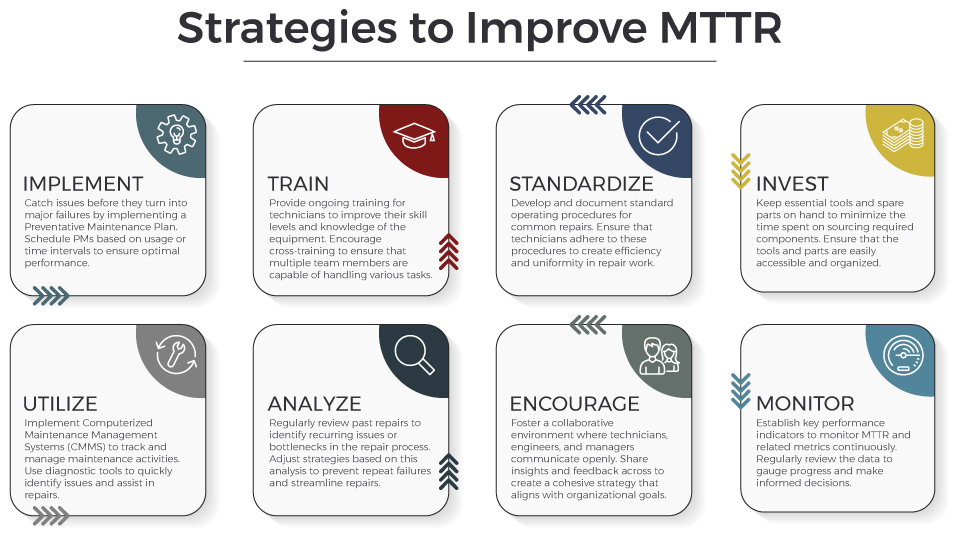Mean Time To Repair (MTTR) serves as a critical baseline for amplifying efficiency, curtailing unexpected downtime, and fostering the augmentation of the bottom line. Prolonged repair durations of essential equipment could lead to product waste, missed orders, and strained business relationships. Herein, MTTR becomes an instrumental tool helping organizations discern reasons behind prolonged maintenance durations and make informed decisions to rectify the underlying causes.
Understanding the Role of MTTR in Maintenance Management
Analyzing MTTR provides profound insights into your maintenance operation's approach towards equipment procurement, maintenance scheduling, and task completion. In essence, MTTR aids in eradicating inefficiencies leading to production losses and the monetary implications that accompany such losses.
Making Informed Decisions: Repair or Replace
MTTR proves instrumental in deciding whether to repair or replace aging assets. When an asset's repair time increases with its age, it may be more economical to replace it. Moreover, MTTR can guide the purchasing and design process by predicting the lifecycle costs of new systems.
Scheduling Preventive Maintenance
Tracking MTTR helps ensure that your preventative maintenance program and tasks are as effective and efficient as possible. Even though MTTR quantifies as reactive maintenance, assets taking longer to repair might be associated with ineffective PMs. MTTR serves as a gateway to the root cause of such problems, offering a path to the solution.
When MTTR shows an increasing trend, it might be due to non-standardized PMs, leading to more equipment failures. A work order might instruct a technician to lubricate a part, but might not specify the type or amount of lubricant. Including these details in a work order ensures swift and accurate work, leading to lesser downtime.
Inventory Purchasing and Planning in Maintenance, Repair, and Operations (MRO)
An unusually long MTTR might be a sign that your parts strategy is ineffective. Stockouts and disorganized spares significantly impact delayed work. According to a report, lack of spare parts can be linked to about 50% of all unscheduled downtime.
If a longer MTTR is consistently observed for certain assets or parts of the plant, it's worth investigating if parts are the cause. Check if critical parts are chronically understocked, defective, or mislabeled.
Digging Deeper into MTTR
"Mean time to" in any phrase indicates the average time between two events. MTTR, a crucial metric for maintenance departments, measures the average time required to identify the cause of and fix failed equipment. It offers a snapshot of the maintenance team's response time to and repair time of unplanned breakdowns.
-
The MTTR calculation includes the period from the incident's commencement to the time the equipment or system returns to production. It encompasses several stages:
- Informing maintenance technicians
- Diagnosing the issue
- Resolving the issue
- Reassembling, aligning, and validating equipment
- Resetting, testing, and starting up the equipment or system for production
Please note that the MTTR formula overlooks the lead time for spare parts and doesn't apply to planned maintenance tasks or shutdowns.
Mean Time to Repair vs Mean Time to Recovery: A Comparison
The "R" in MTTR is often used interchangeably with "repair" and "recovery". While "repair" focuses on the repair time only, "recovery" includes the repair time plus the testing period and the time taken to return to normal operation. The need to distinguish between the two arises in the context of maintenance contracts or service level agreements (SLAs), ensuring everyone is clear on what's being measured.

Cracking the MTTR Calculation Formula
The MTTR formula, represented in hours, is the total maintenance time divided by the total number of repairs (failures). This formula assumes tasks are performed sequentially and by trained maintenance personnel.
-
Here's a straightforward example to calculate MTTR: Suppose an asset equipment fails five times in a 60-day period. The repair times for each failure were as follows:
- 1st failure: 2 days to repair
- 2nd failure: 1 day to repair
- 3rd failure: 3 days to repair
- 4th failure: 2 days to repair
- 5th failure: 2 days to repair
To calculate the MTTR, you simply add up the repair times and divide by the number of failures. In this case, the Mean Time To Repair this particular asset over the 60 day period is 2 days.

Keep in mind two assumptions when calculating MTTR:
- Every instance of failure differs in severity, so while some breakdowns might require days to repair, others might take only minutes. As such, MTTR provides an average of what to expect.
- It's crucial that every instance of failure is attended to by competent and properly trained maintenance personnel following standardized procedures. This ensures reliable results.

Technology's Role in Reducing MTTR
Implementing modern monitoring technologies is perhaps the best chance for an organization to reduce its MTTR. Real-time data analysis and smart decision-making are introduced into the manufacturing world through the Industrial Internet of Things (IIoT). This allows for real-time data analysis for tracking failure data when equipment breaks down, and automatically gathering, aggregating, and analyzing data before sending a recommended action to technicians.
The Last Word: Taking the Guesswork Out of MTTR Metrics
Now that you know what MTTR is, how and when to use it, you can get started on increasing your productivity. Remember to consider outliers, off-peak periods of time usage, as well as additional metrics like Mean Time To Failure (MTTF) and MTTR.